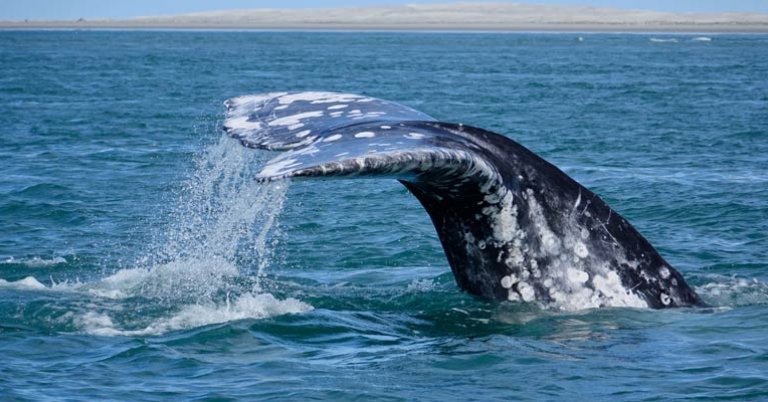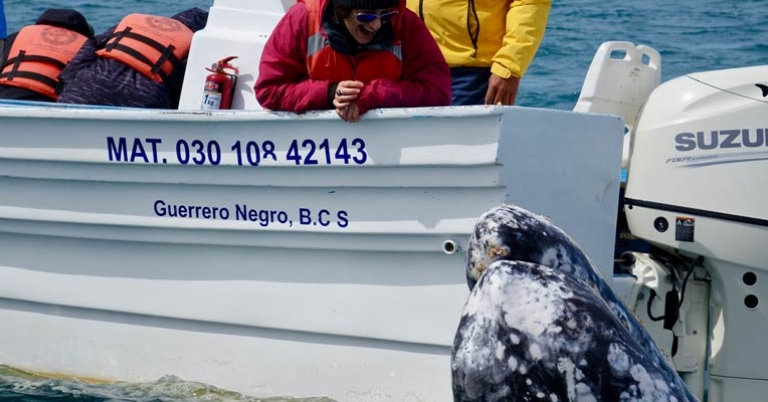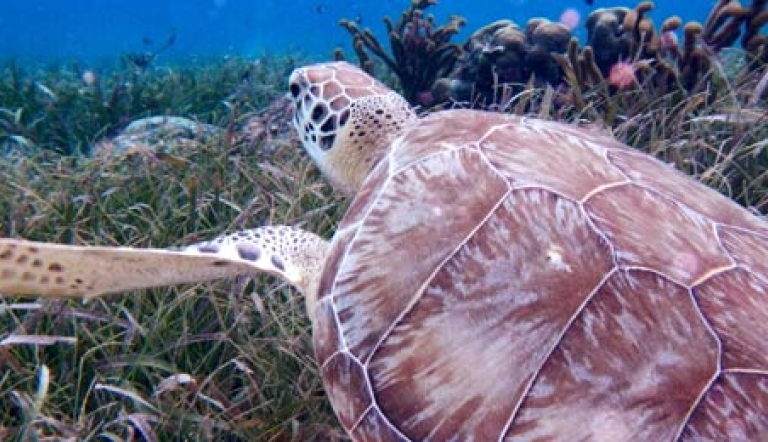Baja Mexico | Gray Whales and Desert Trails
Date:
Activity Level:
Duration:
Price:
Interests:
About this trip
This 6-day trip offers a unique opportunity to visit the two best gray whale calving lagoons without compromising comfort and amenities. Our trip begins and finishes at the luxurious Hotel La Mision in charming Loreto. We’ll travel through the desert landscape in a comfortable motorcoach and settle in for three nights at the unique and tranquil Ignacio Springs. Working with local naturalists, Kevin & Sharon will introduce you to the behaviors and majesty of the migratory gray whales and lead you on short walks through the scenic desert landscape of Baja Peninsula.
Highlights
- Luxury accommodations throughout:
- Loreto – Hotel La Mision overlooking the sparkling Sea of Cortez.
- San Ignacio – Ignacio Springs, a tranquil, palm-treed oasis.
- Close encounters with friendly Gray Whales
- with Malarrimo on Scammon’s Lagoon
- with Kuyima on San Ignacio Lagoon
- Easy walks in the desert and on the beach
- Bird watching & fresh air
- Learn about the natural history of Baja
- Good food, new friendships
About your naturalist leaders
 Sharon & Kevin design bespoke itineraries that combine wildlife encounters, outstanding scenery and easy walking. Experiencing the wonders of nature with friends, they create a lively group travel culture that promotes learning and well-being. They’ve designed and led extraordinary tours in Baja, Costa Rica, Alaska, Southern Africa, Peru and Ecuador. At home in Northern California, Sharon is the hiking instructor for College of Marin and a science teacher at Marin Country Day School. Kevin is a marine biologist with almost a thousand sea days observing fisheries, whales and seabirds. www.MarinNature.com
Sharon & Kevin design bespoke itineraries that combine wildlife encounters, outstanding scenery and easy walking. Experiencing the wonders of nature with friends, they create a lively group travel culture that promotes learning and well-being. They’ve designed and led extraordinary tours in Baja, Costa Rica, Alaska, Southern Africa, Peru and Ecuador. At home in Northern California, Sharon is the hiking instructor for College of Marin and a science teacher at Marin Country Day School. Kevin is a marine biologist with almost a thousand sea days observing fisheries, whales and seabirds. www.MarinNature.com
$4,440
Per person
About this price
Land cost only. Does not include round-trip airfare to and from destination.
Single room supplement $600
What makes us different
Rich content
Wildlife up-close
Local cuisine
Low stress travel planning
Expert guides
Service anytime
Daily Itinerary
Print ItineraryLoreto
San Ignacio
San Ignacio
San Ignacio
Loreto
Departure
Pricing
Print Pricing$4,440
Per person
About this price
Land cost only. Does not include round-trip airfare to and from destination.
Single room supplement $600
What's Included
- Activities and meals as mentioned in itinerary
- Full time guide for the duration of your program
- Private transportation and driver for the duration of the program
- Arrival and departure transfers based on individual flight schedules
- All tips
- Bottled water or water refill station during transfers
- Non alcoholic beverage with meals
What's Not Included
- International airfare
- Travel Insurance
- Items of personal nature
Pricing Details
A $500 per person deposit is due to hold your space on this trip. This deposit is not refundable. 95 - 0 days before departure: 100% of program price is forfeited.
Holbrook Travel strongly recommends the purchase of travel protection for medical emergencies while traveling and to protect your investment. Please note the purchase of Cancel for Any Reason Coverage or to exclude pre-existing conditions with Trip Cancellation coverage may require policy purchase within 10-14 days of your initial deposit, depending upon the provider.
Single room supplement $600
Final payment due date: November 14, 2025
Travel Info
Print Travel InfoEntry & Exit Requirements
U.S. citizens must have a valid passport book to enter Mexico. Passports must be valid for at least the duration of your stay. As this requirement is subject to change at any time without notice, we recommend at least 6 months’ validity. A passport card (as opposed to a book) is not acceptable for entry by air.
If you are not traveling with a U.S. passport, please check with the Mexican Embassy for the requirements based on your nationality.
Health Information
Immunizations
The Centers for Disease Control recommends that all travelers be up to date on routine vaccinations such as measles-mumps-rubella (MMR) vaccine, diphtheria-pertussis-tetanus vaccine, varicella (chicken pox) vaccine, and your yearly flu shot before every trip.
There are no vaccinations required for entry into Mexico, unless you are traveling from a country where yellow fever transmission is a risk.
Though not required, tThe CDC recommends inoculation against hepatitis A, hepatitis B, and typhoid for most unvaccinated travelers to Mexico.
Please consult your physician for additional information and recommendations based on your individual circumstances.
Malaria
The CDC does not consider travelers to the Baja Peninsula to be at risk for malaria.
Dengue Fever and Other Insect-borne Illnesses
The CDC warns that dengue fever is a potential risk in Mexico. In addition, locally transmitted cases of Zika virus, Chagas disease, and other insect-borne illnesses have previously been reported. As there are currently no vaccines available for these illnesses, the CDC recommends that travelers take precautions to avoid insect bites. To protect against mosquitos and other biting insects, cover exposed skin with lightweight, long-sleeved shirts and pants, consider treating clothes with permethrin, and use an insect repellent containing an active ingredient like DEET or picaridin. Apply sunscreen first, followed by the repellent (preferably 20 minutes later).
After spending time outdoors, especially in grassy or wooded areas, the CDC recommends showering and conducting a full-body check for ticks. If you find a tick attached to your skin, safely remove it with tweezers as soon as possible.
As a precaution, the CDC advises women who are pregnant to consider postponing travel to any area where Zika virus transmission is ongoing.
Travelers’ Diarrhea
The CDC warns that travelers’ diarrhea is the most common travel-related illness. Consumption of contaminated food and water may cause diarrhea. To avoid this, do not drink tap water, and use bottled water to brush your teeth. Avoid ice and uncooked vegetables or fruit without a peel. When in doubt, ask your guide. Restrict yourself to cooked food at restaurants, and avoid food sold on the streets. If you contract diarrhea, it is very important to drink large quantities of purified water. Consult your doctor for appropriate medication should you contract diarrhea.
Some people are extremely sensitive and may get diarrhea simply because of dietary changes. If you are prone to gastrointestinal issues, consult your physician or nutritionist for preventative measures.
Sun Exposure
The effects of the sun can be damaging to the eyes and skin. Spending time outdoors exposes you to the sun’s harmful ultraviolet (UV) rays, even on cloudy days. To protect yourself from the sun, use a broad spectrum sunscreen of at least SPF 15, protect skin with clothing, wear a wide-brimmed hat and sunglasses, and drink plenty of fluids.
Sea Sickness
If you’re prone to motion/sea sickness, discuss sea sickness prevention techniques with your physician before your trip. You may consider packing over-the-counter medications like Dramamine or Bonine, or see your physician for a Scopolamine prescription.
If you experience sea sickness, try facing forward and focusing on a steady distant point, like the horizon.
Respiratory Illness Protocols
Please review our Respiratory Illness Protocols page, which explains our policy and procedures if you or another traveler should develop symptoms of a respiratory illness during your trip. Your participation in a Holbrook Travel program indicates that you are in agreement with these protocols.
Resources
Print ResourcesSuggested Packing List
Everyone has personal preferences when it comes to packing; for this reason, the information below is offered as a general guide and not a definitive list. You know yourself best: Use your discretion and pack what you think will serve you, based on your personal preferences and specific itinerary.
You may find many of the items below in the New Headings Gear Store. Use code HolbrookGuest10 for a 10% discount on your purchase.
Clothing
Casual, comfortable clothing is suitable for most activities. You may wish to bring a slightly nicer outfit or two (eg sundress, polo shirt) if your itinerary includes dinners out or more formal activities. Bring enough clothing suitable for the length of your program. If you prefer to pack light, note that many hotels offer laundry services at additional cost. Pack clothing that can be worn in layers to adapt to weather changes throughout the day. The climate is arid, and temperatures can get cold (sometimes as low as 40 °F) especially at night and in the early mornings. During the day, it usually warms up considerably, with highs in the 60s, 70s, or 80s. For birding programs, pack muted colors such as khaki, olive, and forest green.
- A combination of short-sleeved and lightweight, long-sleeved shirts for sun and insect protection
- Shorts
- Lightweight, quick-drying long pants for sun and insect protection
- Undergarments
- Sleepwear
- Jacket or sweater/sweatshirt
- 1-2 bathing suit(s)
- Socks – Bring extra pairs.
- Shoes – Consider your specific itinerary when choosing footwear. For most programs, you’ll likely want at least one pair of comfortable, closed-toe, water-resistant or waterproof walking or hiking shoes with thorn-proof soles, suitable for desert hikes and walking over cobblestones or other uneven terrain. Sturdier hiking boots may be appropriate for more active itineraries. In addition, many participants opt for a pair of sturdy sport-strap sandals (e.g. Keens, Tevas, or similar) and/or casual flip-flops or sandals. You may also want a pair of aqua socks, reef walkers, or water shoes.
- Rain gear – Rain is infrequent most of the year, but a lightweight rain jacket, hooded poncho, and/or windbreaker are recommended for the whale outings to keep you dry from the spray from the boat.
- Visor or wide-brimmed sun hat
- Bandana, scarf, or neck gaiter
Personal Toiletries
- Shampoo, conditioner, lotion, deodorant/antiperspirant , etc. – If possible, avoid strong fragrances if you are sensitive to insect bites (and to be considerate of your fellow travelers).
- Soap and washcloth or a small, quick-drying microfiber towel – These items are not always standard in hotels outside the US, so you may wish to bring them with you.
- Hairbrush, comb, hair ties, shower cap. Most—but not all—hotel rooms provide a hair dryer, but you may wish to bring one from home.
- Toothbrush and toothpaste
- Razor
- Ear plugs, especially if you are a light sleeper
- Personal hygiene products
- Insect repellent with DEET or picaridin
- Sunscreen and lip balm with SPF – If you’ll be in the ocean, we recommend reef-safe sunscreen.
- Aloe vera gel
- A travel pack of tissues – also useful as napkins or toilet paper if needed
In addition to your personal toiletries, it is useful to pack a small medical kit, which you can easily prepare. Helpful items might include: bandages, antihistamine, a pain reliever, motion sickness medication, anti-diarrhea medicine, individually wrapped pre-moistened towelettes and/or hand sanitizer, antibiotic ointment, anti-fungal cream, moleskin for blisters, eye drops, tweezers, a mini sewing kit, and an extra pair of contact lenses or eyeglasses if you wear them.
Miscellaneous
Remember to pack valuables such as your passport, cash/credit cards, and medications in your carry-on luggage.
- Passport, FMM (if you've printed it in advance), and photocopies of all travel documentation
- Personal insurance card and travel insurance information
- Money – ATM/credit card and cash; small bills in good condition are recommended
- Prescription medicines (if applicable), with a copy of the prescription
- Sunglasses
- Small day pack for hikes and excursions
- Flashlight and/or head lamp
- Travel alarm clock or inexpensive waterproof wristwatch with alarm – Not all hotels provide alarm clocks.
- A pocket calculator or cell phone to assist with conversions and currency exchange
- Binoculars with lens cleaner
- Camera and related equipment, such as charger, lenses, and extra memory cards
- Reusable water bottle
- Non-perishable snacks
- Pocket-knife or multipurpose tool - Pack in your checked luggage
- Zip-top style bags – useful for packing toiletries, sorting clothing, storing damp or muddy shoes, or as a dry bag for protecting electronics or cameras (especially on the whale excursions)
- Notepad or travel journal and pen
- Music or reading material for down time, long drives, or on the airplane, and a portable bright light to read by
- Collapsible walking stick with rubber tip
- Money belt
- Chargers for electronics

Questions
Contact Sandy Schmidt at 877-907-5360 or email Sandy.














